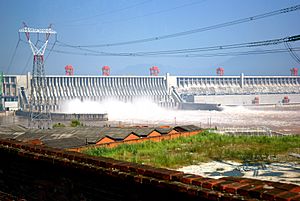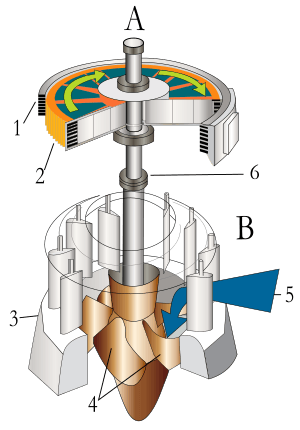Hydropower facts for kids

Hydropower is a way of getting useful energy from moving water. It's a clean and powerful source of energy.
Long ago, people used the power of water for many things. In the 1830s, during the time of building many canals, hydropower helped move boats up and down hills. Industries that needed water power had to be built close to waterfalls. For example, in the late 1800s, many flour mills were built at Saint Anthony Falls in the Mississippi River. These mills were very important for the city of Minneapolis to grow. Today, the main use of hydropower is to make electric power. This allows us to use cheap energy far away from the water source.
Contents
Types of Water Power
There are different ways to use the power of water:
- Water wheels: These have been used for hundreds of years to power mills and machines.
- Hydroelectric energy: This usually refers to electricity made by large dams.
- Tidal energy: This captures energy from the ocean's tides moving sideways.
- Tidal stream power: This captures energy from tidal currents moving up and down.
- Wave power: This uses the energy found in ocean waves.
Hydroelectric Power
Main article: Hydroelectricity
Hydroelectric power is a way to make electricity without burning fuel. About 19% of the world's electricity comes from hydroelectric power. This is about 715,000 MW (megawatts). Even today, new large dams are still being planned and built.
Hydroelectric power is often used when there is a high demand for electricity. This is because it can be started and stopped quickly. However, most good places for large hydroelectric dams in developed countries are already being used. Also, environmental concerns can sometimes stop new projects.
A big plus for hydropower is that it makes almost no carbon dioxide or other harmful gases. This means it does not add much to global warming. Electricity from hydropower can also be much cheaper than electricity from burning fossil fuels or from nuclear energy. Areas with lots of hydropower often attract many industries.
A great benefit of hydroelectric dams is their ability to handle busy times when lots of electricity is needed. When less electricity is needed, the dam can simply store more water. Some power plants even use dams to store extra energy. They use electricity to pump water back up into a higher basin. Then, when demand for electricity goes up, they release the water to make power. Sometimes, using stored water in river dams can be tricky because of the need for water for farming.
Tidal Power
Using the power of tides in a bay or estuary has been done in countries like France (since 1966), Canada, and Russia. It could also work in other places where the tide changes a lot. The water trapped by a tidal barrier turns turbines as it flows out or in. One challenge is that this system makes electricity in bursts, usually every six hours. This can limit how tidal energy is used.
Tidal Stream Power
This is a newer technology. Tidal stream generators get energy from water currents, much like wind turbines get energy from wind. Because water is much denser than air, even a single generator can make a lot of power. This technology is still quite new and needs more research.
However, several test versions have been tried in the UK, France, and the USA. For example, in 2003, a turbine that could make 300 kW (kilowatts) was tested in the UK. A Canadian company, Blue Energy, plans to install many tidal current devices. They call this a 'tidal fence' and plan to put them in different places around the world.
Wave Power
The motion of ocean surface waves might produce much more energy than tides. It has been proven that making energy from waves is possible, especially in Scotland in the UK. But there are still many technical problems to solve.
A test wave power generator is being built in Port Kembla, Australia. It is expected to make up to 500 MWh (megawatt-hours) of electricity each year. This system captures wave energy using an air-driven generator. For countries with long coastlines and rough seas, wave energy could provide a lot of electricity. Any extra power made during rough seas could even be used to make hydrogen.
Related Pages
Images for kids
-
A water piston from the Nongshu by Wang Zhen (fl. 1290–1333)
-
Saint Anthony Falls, United States; hydropower was used here to mill flour.
-
Chief Joseph Dam near Bridgeport, Washington, is a major run-of-the-river station without a sizeable reservoir.
-
The upper reservoir and dam of the Ffestiniog Pumped Storage Scheme in Wales. The lower power station can generate 360 MW of electricity.
See also
 In Spanish: Energía hidráulica para niños
In Spanish: Energía hidráulica para niños









